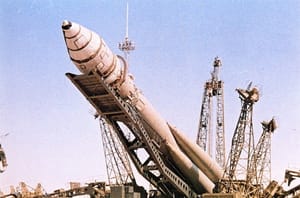
Mar 11, 2024
First steps into the Universe: Vostok 1 & 6
For almost the past sixty-three years people have been traveling to and from space with almost seven hundred people traveling past the Kármán line and looking back down on the Earth below. Few people are aware of the almost a dozen humans in space permanently now and even fewer know of the first man and woman to go into space. So let's briefly go over the missions of Yuri Gagarin and Valentina Tereshkova.
Flight of Yuri Gagarin

Yuri Gagarin's flight occurred on the 12th of April 1961 with the mission being dubbed Vostok 1. Gagarin's flight took off from the Baikonur Cosmodrome in the Kazakh Soviet Socialist Republic, which was part of the Union of Soviet Socialist Republics and is now modern-day Kazakhstan, at 06:07 am Universal Coordinated Time.
After an approximately ten-minute flight into orbit atop of a modified R-7 rocket, Gagarin was placed into aboard of the Vostok-1 spacecraft. During his time on orbit, several messages were sent to and from the spacecraft asking Gagarin about his health and the progress of tests. The tests of Vostok-1 were related to how the human body reacts to the environment of space.
Gagarin spent 1 hour and forty-eight minutes in orbit aboard Vostok-1 with the capsule carrying him through re-entry. After re-entry into the Earth's atmosphere, Gagarin was ejected seven kilometers up where he landed using his own parachute a few minutes later. The capsule of the Vostok-1 spacecraft also landed under a parachute shortly after.
Flight of Valentina Tereshkova

Valentina Tereshkova's flight occurred on the 16th of June 1963 with the mission being dubbed Vostok-6. Tereshkova's flight also took off from the Baikonur Cosmodrome in the Kazakh Soviet Socialist Republic, which was part of the Union of Soviet Socialist Republics and is now modern-day Kazakhstan, at 09:29 am Universal Coordinated Time.
Tereshkova's Vostok spacecraft was also launched on a modified R-7 rocket with the launch lasting approximately ten minutes. During her time in orbit, Tereshkova kept a flight log, took photographs, and manually controlled the orientation of the spacecraft. Other tests of Vostok-6 were related to how a woman's body reacts to the environments of space and if there are any differences compared to men.
The Vostok-6 mission lasted for two days twenty-two hours and fifty minutes with the capsule protecting Tereshkova during re-entry into the atmosphere. Similarly to Gagarin's flight, Tereshkova was ejected from the capsule and landed using her own parachute.
What was the Vostok spacecraft?
The Vostok spacecraft was used for six crewed missions and was composed of a capsule and a service module. The capsule was spherical and housed one astronaut and had a large part of its internal volume taken up by the ejection seat. The service module houses the spacecraft's fuel, electronics, and other instruments. Powering the reentry burns was a single S5.4 engine.




